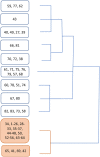TaSCA, an Agile Survey on Chemosensory Impairments for Self-Monitoring of COVID-19 Patients: A Pilot Study
- PMID: 33716936
- PMCID: PMC7943440
- DOI: 10.3389/fneur.2021.633574
TaSCA, an Agile Survey on Chemosensory Impairments for Self-Monitoring of COVID-19 Patients: A Pilot Study
Abstract
Background/Objective: During the COVID-19 pandemic, smell and taste disorders emerged as key non-respiratory symptoms. Due to widespread presence of the disease and to difficult objective testing of positive persons, the use of short surveys became mandatory. Most of the existing resources are focused on smell, very few on taste or trigeminal chemosensation called chemesthesis. However, it is possible that the three submodalities are affected differently by COVID-19. Methods: We prepared a short survey (TaSCA) that can be administered at the telephone or through online resources to explore chemosensation. It is composed of 11 items on olfaction, taste, and chemesthesis, in order to discriminate the three modalities. We avoided abstract terms, and the use of semiquantitative scales because older patients may be less engaged. Statistical handling included descriptive statistics, Pearson's chi-squared test and cluster analysis. Results: The survey was completed by 83 persons (60 females and 23 males), which reported diagnosis of COVID-19 by clinical (n = 7) or molecular (n = 18) means, the others being non-COVID subjects. Cluster analysis depicted the existence of two groups, one containing mostly asymptomatic and one mostly symptomatic subjects. All swab-positive persons fell within this second group. Only one item, related to trigeminal temperature perception, did not discriminate between the two groups. Conclusions: These preliminary results indicate that TaSCA may be used to easily track chemosensory symptoms related to COVID-19 in an agile way, giving a picture of three different chemosensory modalities.
Keywords: COVID-19; chemesthesis; chemical senses; olfaction; recovery; self-assessment; taste; trigeminus.
Copyright © 2021 Mucignat-Caretta, Bisiacchi, Marcazzan, Calistri, Parolin and Antonini.
Conflict of interest statement
The authors declare that the research was conducted in the absence of any commercial or financial relationships that could be construed as a potential conflict of interest.
Figures



Similar articles
-
Are Multiple Chemosensory Systems Accountable for COVID-19 Outcome?J Clin Med. 2021 Nov 28;10(23):5601. doi: 10.3390/jcm10235601. J Clin Med. 2021. PMID: 34884303 Free PMC article. Review.
-
Smell, taste and chemesthesis disorders in patients with the SARS-CoV-2 during Omicron variant pandemic in China.Heliyon. 2023 Oct 5;9(10):e20715. doi: 10.1016/j.heliyon.2023.e20715. eCollection 2023 Oct. Heliyon. 2023. PMID: 37842559 Free PMC article.
-
Chemosensory Dysfunction in Long-Term COVID-19 Assessed by Self-Reported and Direct Psychophysical Methods.Life (Basel). 2022 Sep 25;12(10):1487. doi: 10.3390/life12101487. Life (Basel). 2022. PMID: 36294922 Free PMC article.
-
Evaluating the Onset, Severity, and Recovery of Changes to Smell and Taste Associated With COVID-19 Infection in a Singaporean Population (the COVOSMIA-19 Trial): Protocol for a Prospective Case-Control Study.JMIR Res Protoc. 2020 Dec 31;9(12):e24797. doi: 10.2196/24797. JMIR Res Protoc. 2020. PMID: 33351775 Free PMC article.
-
Sudden onset, acute loss of taste and smell in coronavirus disease 2019 (COVID-19): a systematic review.Acta Odontol Scand. 2020 Aug;78(6):467-473. doi: 10.1080/00016357.2020.1787505. Epub 2020 Aug 7. Acta Odontol Scand. 2020. PMID: 32762282
Cited by
-
Are Multiple Chemosensory Systems Accountable for COVID-19 Outcome?J Clin Med. 2021 Nov 28;10(23):5601. doi: 10.3390/jcm10235601. J Clin Med. 2021. PMID: 34884303 Free PMC article. Review.
References
-
- Lechien JR, Chiesa-Estomba CM, De Siati DR, Horoi M, Le Bon SD, Rodriguez A, et al. . Olfactory and gustatory dysfunctions as a clinical presentation of mild-to-moderate forms of the coronavirus disease (COVID-19): a multicenter European study. Eur Arch Otorhinolaryngol. (2020) 277:2251–61. 10.1007/s00405-020-05965-1 - DOI - PMC - PubMed
LinkOut - more resources
Full Text Sources
Other Literature Sources

